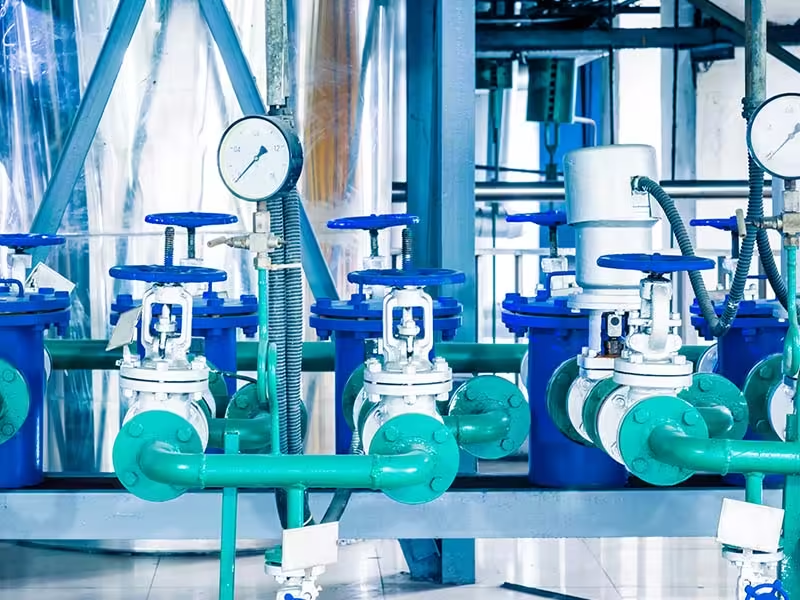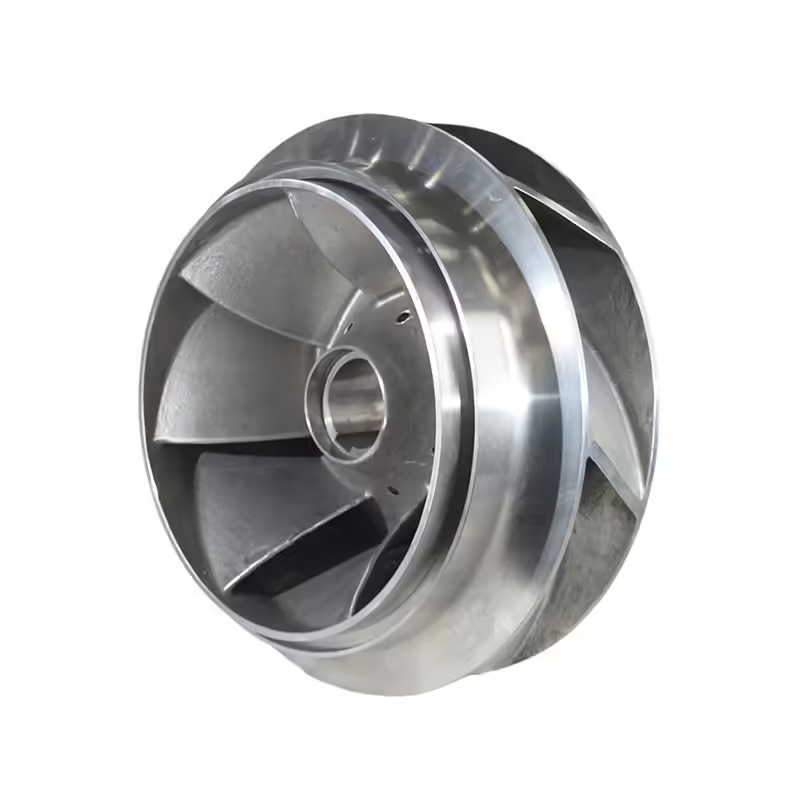كيفية تغيير المكره: 5 خطوات سهلة لتحسين الكفاءة
مرحباً بكم في مدونتي!
يسعدني وجودك هنا! قبل أن نتعمق في المحتوى، أود أن تنضموا إليّ على منصات التواصل الاجتماعي. هناك أشارككم أفكارًا إضافية، وأتواصل مع مجتمعنا الرائع، وأُطلعكم على آخر الأخبار. إليكم كيفية البقاء على تواصل:
📘 فيسبوك: شركة شنغهاي لييروو الصناعية التجارية المحدودة
الآن، لننطلق في هذه الرحلة معًا! آمل أن تجدوا هذا المحتوى مفيدًا ومُلهمًا وقيّمًا. هيا بنا!
جدول المحتويات
مقدمة

ال المكره يُعدّ جزءًا أساسيًا من العديد من الأنظمة الميكانيكية، وخاصةً في المضخات والمحركات والتوربينات. يلعب دورًا هامًا في نقل الطاقة إلى السائل الذي يُحرّكه، ولذلك تعتمد كفاءة نظامك بشكل كبير على حالته. مع مرور الوقت، قد تتآكل المراوح، مما يُقلل من الكفاءة الكلية للنظام. لذا، فإن معرفة كيفية تغيير أجزاء المراوح بشكل صحيح تُعدّ أمرًا أساسيًا للحفاظ على سلاسة التشغيل.
في هذه المقالة، سنرشدك خلال خطوات تغيير المروحة، ونشرح أهمية ذلك، ونقدم نصائح لضمان استبدال سلس. باتباع هذه الخطوات، ستحسّن كفاءة نظامك وتتجنب مشاكل الأداء لاحقًا.
لماذا تحتاج إلى تغيير المكره بانتظام
قبل الخوض في خطوات تغيير المكره، من المهم فهم أهمية هذه الصيانة. وظيفة المكره هي نقل السوائل أو الغازات عن طريق توليد طاقة دورانية، وهي ضرورية لأداء العديد من الآلات. مع مرور الوقت، قد يتعرض المكره للتلف أو التآكل، مما يؤدي إلى انخفاض كفاءته واحتمال تلف النظام بأكمله.
فيما يلي بعض الأسباب الرئيسية التي تدفعك إلى تغيير مكونات المكره:
- التآكل والتلف:قد يؤدي الاستخدام المستمر إلى تآكل الدافع، وخاصة في البيئات ذات الضغط العالي أو درجة الحرارة أو المواد المسببة للتآكل.
- انخفاض الأداء:ستواجه المكرهة البالية صعوبة في تحريك السوائل بكفاءة، مما يؤدي إلى ضعف أداء النظام.
- منع المزيد من الضرر:إن تأخير التغيير قد يؤدي إلى انخفاض كفاءة أجزاء أخرى من النظام أو حتى انهيارها.
الخطوة 1: التحضير لاستبدال المكره

قبل البدء في عملية كيفية التغيير المكره بالنسبة للأجزاء، الخطوة الأولى هي التحضير. التحضير الجيد يضمن عملية آمنة وفعالة وسلسة. إليك ما عليك فعله:
- إيقاف تشغيل الطاقة:تأكد من إيقاف تشغيل النظام بالكامل وفصله عن أي مصادر كهربائية.
- جمع الأدوات:اعتمادًا على نوع الدافع والنظام، ستحتاج إلى مجموعة من الأدوات مثل المفاتيح، ومفكات البراغي، والساحب.
- معدات السلامة:ارتدِ القفازات والنظارات والملابس الواقية لتجنب أي إصابات أثناء التعامل مع الأجزاء الحادة أو المواد الخطرة.
- تحقق من دليل الشركة المصنعة:راجع دائمًا تعليمات الشركة المصنعة للحصول على إرشادات محددة حول استبدال المكره.
من خلال اتباع هذه الخطوة التحضيرية، ستتجنب المشكلات غير الضرورية أثناء عملية استبدال الدافع.
الخطوة 2: إزالة الدافع القديم
الخطوة التالية في تعلم كيفية التغيير المكره تتمثل إحدى خطوات إصلاح المروحة في إزالة المروحة القديمة. هذه الخطوة بالغة الأهمية، إذ قد يؤدي الإزالة غير الصحيحة إلى إتلاف مكونات أخرى أو إعاقة تركيب المروحة الجديدة. إليك كيفية المتابعة:
- إزالة المثبتات والمسامير:قم بإزالة أي براغي أو مسامير أو مثبتات تثبت المكره في مكانه بعناية.
- استخدم ساحبًا:إذا تم تثبيت المكره بإحكام، استخدم ساحب المكره لإزالته بأمان من العمود.
- فحص العمود:بمجرد إزالة الدافع، افحص العمود بحثًا عن أي علامات تآكل أو تآكل أو تلف.
من الضروري التعامل مع الدافع بعناية أثناء إزالته لتجنب التسبب في أي ضرر قد يؤثر على الدافع الجديد أو المكونات المحيطة.
الخطوة 3: تثبيت المكره الجديد
بمجرد إزالة القديم بنجاح المكره, حان وقت تركيب النظام الجديد. عملية التركيب بالغة الأهمية، فأي خلل في المحاذاة أو التركيب قد يؤثر على أداء النظام. اتبع الخطوات التالية لضمان التركيب الصحيح:
- محاذاة المكره:ضع الدافع الجديد على العمود، مع التأكد من محاذاته بشكل صحيح مع مواصفات النظام.
- تأمين الدافعاستخدم البراغي والمثبتات اللازمة لتثبيت المروحة بإحكام. تأكد من تثبيت المروحة بشكل صحيح.
- التحقق من الدوران الصحيح:قبل إغلاق النظام، قم بتدوير المكره يدويًا للتحقق مما إذا كان يتحرك بحرية وسلاسة.
إذا تم ذلك بشكل صحيح، فيجب تثبيت المكره الجديد بشكل آمن وجاهز للعمل بكفاءة.
الخطوة 4: إعادة تجميع النظام
بعد تركيب المروحة الجديدة، ستحتاج إلى إعادة تجميع النظام. تتضمن هذه الخطوة التأكد من إعادة تركيب كل شيء دون إتلاف أي جزء أو تسريب. إليك كيفية إعادة تجميع النظام:
- أعد توصيل جميع المكونات:تأكد من ربط جميع البراغي والصواميل والبراغي بشكل صحيح.
- فحص الأختام:فحص الأختام أو الحشيات للتأكد من أنها في حالة جيدة وموضوعة بشكل صحيح.
- إعادة تركيب الأغطية الواقية:إذا كان نظامك يحتوي على أغطية أو ألواح واقية، فقم بإعادة تثبيتها لتأمين الدافع ومنع أي تداخل خارجي.
بعد إعادة التجميع، تأكد من أن المكره مثبت في مكانه بشكل آمن قبل الانتقال إلى الخطوة التالية.
الخطوة 5: اختبار النظام
وأخيرا، الخطوة الأخيرة في كيفية التغيير المكره تتضمن عملية فحص الأجزاء اختبار النظام. هذه الخطوة ضرورية لضمان عمل المروحة بشكل صحيح وعمل النظام بأقصى كفاءة. إليك ما يجب عليك فعله:
- تشغيل النظام:أعد تشغيل الطاقة وراقب تشغيل النظام.
- التحقق من وجود تسريبات:ابحث عن أي تسريبات محتملة أو أصوات غير عادية يمكن أن تشير إلى التثبيت غير السليم.
- مراقبة الأداء:تأكد من أن النظام يعمل بكفاءة وأن الدافع الجديد يحرك السائل بشكل فعال.
إذا كان كل شيء على ما يرام، فقد قمت باستبدال المكره بنجاح!
الجدول: قائمة التحقق من استبدال المكره
| خطوة | فعل | ملحوظات |
|---|---|---|
| 1. التحضير | جمع الأدوات، وفصل الطاقة، وارتداء معدات السلامة | اتبع تعليمات الشركة المصنعة |
| 2. إزالة المكره القديم | استخدم ساحبًا، وافحص العمود بحثًا عن أي تلف | تعامل بحذر لتجنب الضرر |
| 3. تركيب المروحة الجديدة | محاذاة وتأمين والتحقق من الدوران | تأكد من التركيب والمحاذاة المناسبة |
| 4. إعادة التجميع | شد المكونات، وتحقق من الأختام | أعد تركيب الأغطية لتأمين المكره |
| 5. نظام الاختبار | قم بتشغيل الجهاز والتحقق من وجود تسريبات أو مشكلات | مراقبة أداء النظام |
متى يجب التغيير المكرهة:علامات تشير إلى أن الوقت قد حان للاستبدال
معرفة متى يجب التغيير المكره إن معرفة مكونات المكره لا تقل أهمية عن فهم كيفية تغيير أجزاء المكره. فالمكرهات أساسية للتشغيل الفعال للعديد من الآلات، لذا فإن التعرّف على علامات التآكل والتلف مبكرًا يمكن أن يمنع حدوث أضرار جسيمة وإصلاحات مكلفة. إليك بعض المؤشرات الرئيسية التي تدل على أن الوقت قد حان لتغيير مكونات المكره:
1. انخفاض الأداء
من أكثر العلامات شيوعًا على ضرورة تغيير مكونات المكره انخفاض ملحوظ في أداء النظام. إذا لم تكن مضختك أو محركك أو توربينك ينقل السوائل بكفاءة، فقد يكون الوقت قد حان لتغيير المكره. فالمكره المتدهور لا ينقل السوائل بالمعدل المطلوب، مما يؤدي إلى انخفاض الكفاءة الكلية للنظام. عند تغيير أجزاء المكره، يستعيد النظام أداءه الأمثل.
2. ضوضاء أو اهتزاز غير عادي
إذا بدأ نظامك بإصدار أصوات أو اهتزازات غير عادية، فقد يشير ذلك إلى وجود مشكلة في المروحة. قد تصبح المروحة التالفة غير متوازنة أو مرتخية، مما يتسبب في حركة غير منتظمة. إذا تُركت دون فحص، فقد يؤدي ذلك إلى مشاكل أكثر خطورة، مثل تلف المحمل أو التآكل المفرط لأجزاء أخرى من النظام. في مثل هذه الحالات، من الضروري تغيير المروحة لمنع المزيد من التلف واستعادة التوازن.
3. الضرر أو التآكل المرئي
يُعد فحص المروحة بحثًا عن أي تلف ظاهر من أفضل الطرق لتحديد ما إذا كانت بحاجة إلى استبدال. مع مرور الوقت، قد تتآكل شفرات المروحة أو تتشقق أو تتآكل، خاصةً في الأنظمة التي تعمل في ظروف قاسية. إذا لاحظت أي تلف ملحوظ في الشفرات أو الهيكل، فقد حان وقت تغيير المروحة. يضمن تغيير المروحة استمرار عمل النظام بكامل طاقته.
4. زيادة استهلاك الطاقة
قد يؤدي عطل أو ضعف كفاءة المروحة إلى إجهاد النظام لإنجاز نفس الناتج. إذا لاحظتَ زيادة مفاجئة في استهلاك الطاقة، فقد يكون السبب هو المروحة. غالبًا ما يكون ذلك بسبب الاحتكاك المفرط أو الدوران غير السليم، وكلاهما يُقلل من كفاءة النظام. سيؤدي تغيير المروحة إلى تقليل استهلاك الطاقة وتحسين الأداء العام للنظام.
5. مشاكل عدم التوازن أو التجويف
التجويف ظاهرة تتشكل فيها فقاعات هوائية وتنهار داخل النظام، غالبًا بسبب خلل في وظيفة المروحة. يؤدي هذا إلى انخفاض كفاءة النظام وقد يؤدي إلى تلف أجزائه الداخلية. إذا كان نظامك يعاني من التجويف، فقد يكون ذلك بسبب تعطل المروحة، مما يستدعي تغييرها. يمكن أن يؤدي تغيير المروحة إلى التخلص من التجويف وتحسين أداء النظام.
6. احتياجات الصيانة والإصلاح المتكررة
إذا وجدت نفسك تقوم بإصلاح أو صيانة الجهاز بشكل متكرر المكره, قد يكون ذلك علامة على اقتراب نهاية عمره الافتراضي. قد يؤدي تعطل المروحة باستمرار إلى توقف متكرر وإصلاحات مكلفة. استبدال المروحة استباقيًا يمنع حدوث المزيد من المشاكل ويحافظ على عمل نظامك بسلاسة. عند تغيير المروحة في الوقت المناسب، يمكنك تقليل تكاليف الصيانة ووقت التوقف بشكل كبير.
خاتمة
معرفة كيفية التغيير المكره يُعدّ تغيير قطع الغيار أمرًا أساسيًا للحفاظ على كفاءة العديد من الأنظمة الصناعية. إن فهم خطوات تغيير مكونات المكره يُحدث فرقًا كبيرًا في أداء آلاتك على المدى الطويل. باتباع الخطوات الخمس السهلة الموضحة في هذه المقالة، يمكنك ضمان عمل نظامك بسلاسة وكفاءة وموثوقية. يُساعد تعلم كيفية تغيير قطع المكره بانتظام على منع تعطل النظام، وتقليل وقت التوقف عن العمل، والحفاظ على سير عملياتك بأعلى أداء. تذكّر أن معرفة وقت تغيير قطع المكره لا يقل أهمية عن العملية نفسها.
تذكر دائمًا مراجعة دليل نظامك واتباع بروتوكولات السلامة المناسبة أثناء عملية الاستبدال. للحفاظ على أداء جهازك، فإن معرفة كيفية تغيير مكونات المروحة بشكل صحيح أمر بالغ الأهمية لضمان طول عمرها وتجنب الإصلاحات غير الضرورية.
الأسئلة الشائعة
ما هو عمر الإنسان؟ المكره?
يختلف عمر المروحة تبعًا للمادة، وظروف تشغيل النظام، وجودة صيانته. عادةً، تدوم المروحة من سنتين إلى خمس سنوات قبل الحاجة إلى استبدالها.
هل يمكنني تغيير الدافع بنفسي؟
نعم، يُمكن تغيير المروحة باتباع الخطوات الصحيحة، وضمان السلامة، واستخدام الأدوات المناسبة. مع ذلك، إذا لم تكن متأكدًا أو كنت تعمل مع أنظمة معقدة، يُنصح باستشارة متخصص.
كيف أعرف متى يجب تغيير الدافع؟
تشمل العلامات التي تشير إلى أن الدافع الخاص بك يحتاج إلى التغيير انخفاض أداء النظام، أو ضوضاء غير عادية، أو اهتزازات، أو تآكل واضح على شفرات الدافع.
فئات المنتجات
- أجزاء الصمامات
- أجزاء مضخة المياه
- أجزاء صندوق المحمل
- أجزاء الصب بالقالب
- منتجات مضخات الفولاذ المقاوم للصدأ
- منتجات مضخات الحديد الزهر
- قطع غيار الصمامات لاستخدام السيارات
- قطع غيار السيارات
- أجزاء الصمامات للاستخدام المدني
- قطع غيار مضخة التفريغ KF

